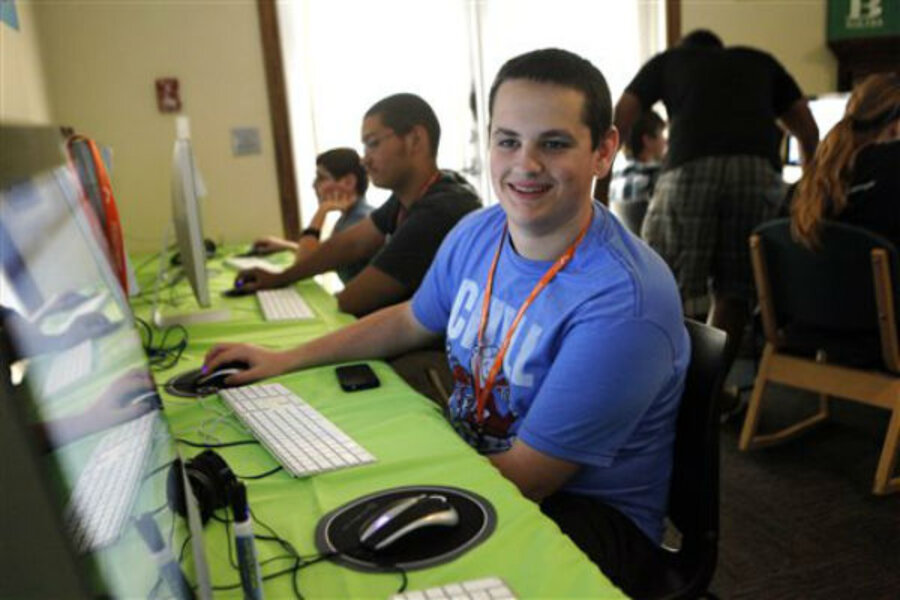Youth coding camps rise in popularity as US demand for programmers increases
Loading...
| Atlanta
The video game Jacob Asofsky is creating is simple: "Someone who is trying to take over the world and you try to stop them."
The 12-year-old from Florida is spending two weeks at a summer camp in a program that teaches programming skills to young people.
"It's about having fun, but it also gives them the tools to be able to do this at home because they don't have this in school," said Taylor Jones, director of the iD Tech Camp at Atlanta's Emory University.
So-called coding camps for children are becoming more popular amid a growing effort to expand access to computer programming and inspire more youths to seek computer science degrees and careers in technology. Their rise underscores a seeming mismatch in the U.S. economy: people like Facebook CEO Mark Zuckerberg and Tumblr founder David Karp illustrate the opportunities programming skills can create, yet universities are not graduating enough code-savvy students to meet employers' demands.
The iD Tech Camps, which have grown from 200 students in 1999 to 28,000 enrolled this year in courses at dozens of locations nationwide, use interest in gaming to build bridges to computer programming and hopefully careers in Web developing, film animation and app creation for smart phones. Courses start at $829 for a one-week course during the day with overnight students paying $1,348.
On a recent weekday, Asofsky was attending an iD Tech Camp on the campus with some 95 other youths under the age of 17. He was using the gaming software RPG Maker to create a video game in which the main character travels around the world, buys animals and armor and interacts with others along the way.
"I have to say the interface of actually making a game is just as fun as playing a game," Asofsky said. "It's a lot like playing a game inside a game."
Early courses for children starting at age 7 use the photo and illustration software Adobe Photoshop and the gaming software Multimedia Fusion to create a simple arcade-style game.
"We sit down and talk about what makes games fun," said instructor Melissa Andrews, who was working with the youngest group of campers. "We get it down to the basics so they can make their own game."
Courses for older children include designing apps, creating sophisticated, 3-D, first-person shooter games using the Unreal Developer's Kit — also known as UDK — and learning programming languages like Java and C++. The idea is to build self-confidence and spark interest in learning how computers work, all to perhaps plant the seed of a future career in programming.
There will be 1.4 million computing jobs by 2020 but only 400,000 computer science students by that time, according to Code.org, a nonprofit with a list of who's who in the tech world on its advisory board including Twitter creator Jack Dorsey and Dropbox CEO Drew Houston.
And the jobs pay well. The median annual wage for a computer programmer, for instance, was $71,380 in 2010, according to the Bureau of Labor Statistics. Meanwhile, jobs for network and computer systems administrators are growing at double the national average, with a median annual salary of $69,160.
Yet high schools and universities seem to be out of step with the job market. Nine out of 10 high schools don't offer computer programming classes and the number of students graduating from college with a computer science degree is down from a decade ago, according to Code.org.
Earlier this year, President Barack Obama said programming should be a required course in high school, similar to foreign languages.
"Given how pervasive computers and the Internet is now and how integral it is into our economy and how fascinated kids are with it, I want to make sure they know how to actually produce stuff using computers and not just simply consume stuff," Obama said during a Google+ Hangout.
Yale Oseroff's high school back in Virginia doesn't offer programming classes. The 17-year-old is spending his fourth year at an iD Tech Camp working through C++, a popular programming language used for systems and application software, for drivers to communicate between an operating system and devices like printers and to create some video games.
"I'm learning (computer) networking, which is what I want to do in college," he said, as he worked on developing a program to capture usernames and passwords and store them in a database.
On the Georgia Tech campus, the Institute for Computing Education offers a variety of camps clustered into elementary, middle and high school groups. Courses include making apps with App Inventor, creating moving sculptures with the WeDo Robotics systems that uses rotational motion and creating animations using Alice software.
Barbara Ericson, director of computer outreach at the Institute for Computing Education at Georgia Tech, said people sometimes ask: why not wait until children are older to start teaching them how to program?
"Anything over the age of 7 is capable, they are capable of learning reasoning," she said.
During a presentation earlier this month at a technology conference in Washington, D.C., Code.org founder Hadi Partovi said less than 5 percent of U.S. high school students spend class time learning computer science while it's a graduation requirement in China. He noted that many "software" jobs are outside the tech industry such as banking, retail, government and entertainment, which makes programming skills particularly versatile.
"It could mean starting your own company," he said. "But it could mean you're a doctor and you're tired of entering the same data into a chart using paper and you want to write an app that does it for you."







